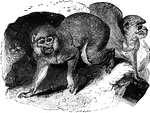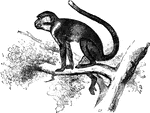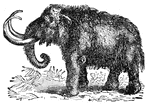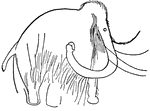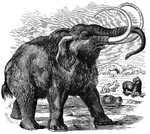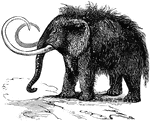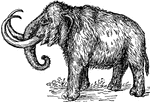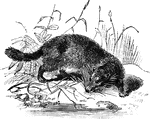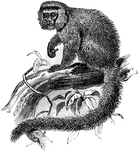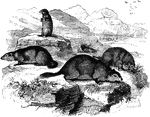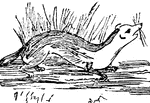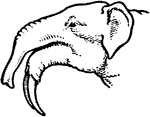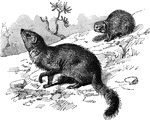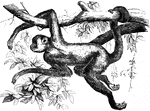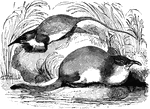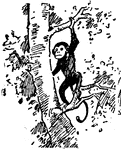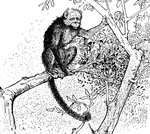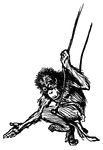The Mammals: M-N ClipArt gallery contains 120 illustrations of mammals starting with the letters "M" and "N" including: : madoqua, magot, mammoth, manatee, mandrill, marmoset, marmot, marten, meerkat, mice, mink, mole, monkey, moose, narwhal, and nylghau.
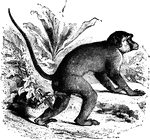
Buffon Macacus
"M. cynomolgus. The hair of this mammal is short, of a brown olive, spotted with black on the…
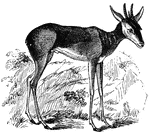
Madoqua
"Is probably the smallest of the horned quadrupeds, it being two feet long and fourteen inches high.…

Mammoth
Animals alive today are but a fraction of all that have been before our time. We are continually discovering…

Mammoth
The Russian name of the large extinct elephant closely resembling the Indian elephant, and of which…

Manatee
the manatee, an aquatic mammal, is found along both shores of the Atlantic in tropical regions and in…

Manatee
"It is of a gray-black color, nine or ten feet long, and has vestiges of nails on the edges of the flippers,…

Manatee
An animal native to the waters of South America, Australia, and West Africa. It is herbivorous, subsisting…
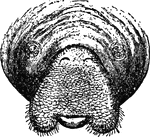
Manatee Face
"Front view of head of American Manatee, showing the eyes, nostrils, and mouth with the lobes of the…
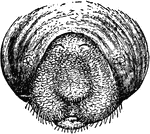
Manatee Face
"Front view of head of American Manatee, showing the eyes, nostrils, and mouth with the lip contracted."…

Manatee on Shore
Manatees are large, fully aquatic marine mammals sometimes known as sea cows. The name manatí…
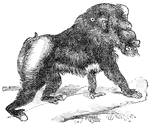
Mandrill
The mandrill is known for its various and brilliant coloration. Its coat is olive brown and it has a…
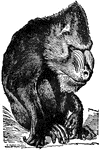
Mandrill
"The Mandrill is an African baboon. It was well known to the ancients. A full grown male measures about…
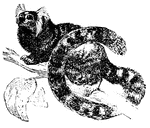
Marmoset
The marmosets are distinguished from other monkeys by their sharp and crooked claws. They are skillful…

Marmot
Native to North America and Eurasia. The best known species of North America are the prairie marmot…

European Marmot
"Marmot is a popular name of the best known European species of this genus." — S. G. Goodrich,…

Marten
"Its head is somewhat triangular , the muzzle pointed, the eyes prominent and lively; the body much…

American Marten
The American marten (Martes americana) is a North American member of the Mustelidae family, sometimes…
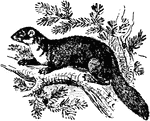
Pine Marten
The pine marten lives most of its life in trees, but does hunt on the ground. It feeds primarily on…
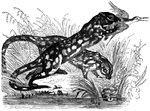
Spotted Martin
"Is eighteen inches long, with a tail nearly as long as the body; its fur is chestnut-color, spotted…
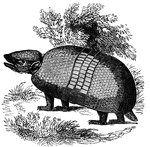
Mataco
"Tolypeutes. It is about fifteen inches long, and having the faculty of rolling itself into a ball,…
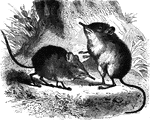
Elephant Mice
"They have long hindlegs, somewhat like gerboas, rather large ears, long tails, and a remarkable long,…
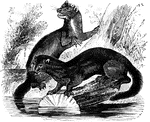
Mink
"The mink has a long slender body, the color varying in different species, is generally dark brown,…

Mink
The common name of several species of fur-bearing quadrupeds, allied to the polecat. Several species…

Mole
The eyes of the mole are very small, but its hearing and smell are acute. Its fur is fine and soft,…

Mole
Moles are well fitted for digging by the very large front feet and strong muscles of the front legs.…
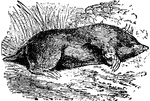
Mole
An insectivorous animal having a barrel-shaped body, very broad fore feet adapted for digging, and burrows…

Mole
Moles are the majority of the members of the mammal family Talpidae in the order Soricomorpha. Although…

Cape Mole Rat
The Cape Mole Rat (Georychus capensis) is a rodent in the Bathyergidae family of blesmols and was also…

Common Mole
" T. Europaea, is found in most parts of Europe, and is well known for its curious cylindrical…
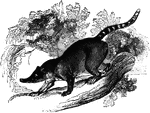
Coati Mondi
"They are distinguished by a long body, a long head terminating in a long flexible snout, with which…
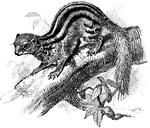
Broad-Striped Malagasy Mongoose
The Broad-Striped Malagasy Mongoose (Galidictis fasciata) is a small mammal in the Eupleridae family…
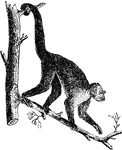
Monkey
A name commonly applied to the whole order of quadrumanous mammals, but the term is limited in its application…
